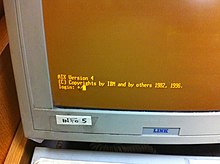Login
This articleneeds additional citations forverification.(February 2024) |

Incomputer security,logging in(orlogging on,signing in,orsigning on) is the process by which an individual gainsaccessto acomputer systemor program byidentifyingandauthenticatingthemselves.
User Credentials
Typically,usercredentialsconsist of ausernameand apassword.[1]These credentials themselves are sometimes referred to asalogin.[2]Modern secure systems often require asecond factor,such asemailorSMSconfirmation for extra security.Social loginallows a user to use an existing cell phone number, or user credentials from another email orsocial networking serviceto sign in or create an account on a new website.
Logging Out
When access is no longer needed, the user canlog out,log off,sign outorsign off.
Procedure

Logging in is usually used to enter a specific page, website or application, which trespassers cannot see.
Once the user is logged in, the login token may be used to track what actions the user has taken while connected to the site.
Logging out may be performed when theusertakes an action, such as entering an appropriatecommandor clicking on an external link. It can also be done implicitly, such as by the user powering off their workstation, closing aweb browserwindow, leaving a website, or not refreshing a website within a defined period.
A login page may have a returnURLparameter, which specifies where to redirect back after logging in or out. For example, it isreturnto=on this site.
In the case of websites that usecookiesto track sessions, when the user logs out, session-only cookies from that site will usually be deleted from the user's computer. In addition, the server invalidates any associations with the session, thereby making any session-handle in the user's cookie store useless.
This feature comes in handy if the user is using apublic computeror a computer that is using apublic wireless connection.As a security precaution, one should not rely on implicit means of logging out of a system, especially not on a public computer; instead, one should explicitly log out and wait for confirmation that this request has taken place.
Logging out of a computer, when leaving it, is a common security practice preventing unauthorized users fromtamperingwith it. There are also people who choose to have a password-protectedscreensaverset to activate after some period of inactivity, thereby requiring the user to re-enter their login credentials to unlock the screensaver and gain access to the system.
Methods of Logging In
They include:
- Image recognition
- Fingerprints scanning
- eye scan
- passwords (oral or textual input)
History and etymology

The terms "login" and "logon" became common with thetime sharingsystems of the 1960s andBulletin Board Systems(BBS) in the 1970s.
Earlyhome computersandpersonal computersdid not generally require them untilWindows NT,OS/2andLinuxin the 1990s.
The termlogincomes from the verb(to) log inand by analogy with the verbto clock in.
Computer systems keep alogof users' access to the system. The term "log" comes from thechip logwhich was historically used to record distance traveled at sea and was recorded in aship's logorlogbook.
Tosign inconnotes the same idea but is based on the analogy of manually signing a log book orvisitor's book.
While there is no agreed difference in meaning between the termslogin,logonandsign-in,different technical communities tend to prefer one over another – Unix, Novell, Linux, and Apple typically uselogin,and Apple'sstyle guidesays"Users log in to a file server (not log on to)...".[3]
By contrast, Microsoft's style guides traditionally suggested the opposite and prescribedlog onandlogon.
In the past,Microsoftreservedsign-into access the Internet,[4]but fromWindows 8onward it has moved to thesign-interminology for local authentication.[5]
See also
- Computer security
- Credential lag
- Login session
- Login spoofing
- OpenID
- Password
- Password policy
- Personal identification number
- /var/log/wtmp
References
- ^"Detail and definition ofloginandlogging in".The Linux Information Project.Archivedfrom the original on 25 December 2019.Retrieved1 January2014.
- ^"Definition oflogin".Oxford Dictionaries.Archived fromthe originalon 7 February 2014.Retrieved8 February2014..
- ^"Apple Style Guide"(PDF).Apple.30 April 2013. p. 96 & 97. Archived fromthe original(PDF)on 17 February 2015.Retrieved17 May2015.
- ^"Use log on or log on to... Do not use log in, login", 2004,Manual of Style for Technical Publications,3rd edition, p. 295, Microsoft.
- ^"Sign in to or out of Windows".Microsoft.Archived fromthe originalon 28 October 2012.Retrieved28 October2012.
